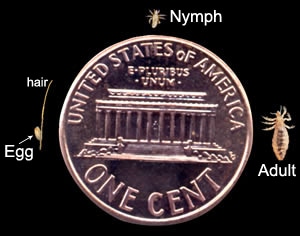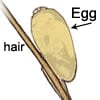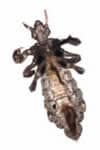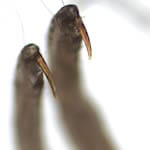Frequently Asked Questions (FAQs)
On This Page
- What are head lice?
- Who is at risk for getting head lice?
- What do head lice look like?
- Where are head lice commonly found?
- What are the signs and symptoms of head lice infestation?
- How did my child get head lice?
- How is a head lice infestation diagnosed?
- How is a head lice infestation treated?
- Is infestation with head lice reportable to health departments?
- I don’t like my school’s head lice policy, can CDC do something?
- Do head lice spread disease?
- Can head lice be spread by sharing sports helmets and headphones?
- Can wigs or hair pieces spread lice?
- Can swimming spread lice?
What are head lice?
The head louse, or Pediculus humanus capitis, is a parasitic insect that can be found on the head, eyebrows, and eyelashes of people. Head lice feed on human blood several times a day and live close to the human scalp. Head lice are not known to spread disease.
Who is at risk for getting head lice?
Head lice are found worldwide. In the United States, infestation with head lice is most common among pre-school children attending child care, elementary schoolchildren, and the household members of infested children. Although reliable data on how many people in the United States get head lice each year are not available, an estimated 6 million to 12 million infestations occur each year in the United States among children 3 to 11 years of age. In the United States, infestation with head lice is much less common among African-Americans than among persons of other races, possibly because the claws of the head louse found most frequently in the United States are better adapted for grasping the shape and width of the hair shaft of other races.
Head lice move by crawling; they cannot hop or fly. Head lice are spread by direct contact with the hair of an infested person. Anyone who comes in head-to-head contact with someone who already has head lice is at greatest risk. Spread by contact with clothing (such as hats, scarves, coats) or other personal items (such as combs, brushes, or towels) used by an infested person is uncommon. Personal hygiene or cleanliness in the home or school has nothing to do with getting head lice.
What do head lice look like?
Head lice have three forms: the egg (also called a nit), the nymph, and the adult.

Actual size of the three lice forms compared to a penny. (CDC Photo)

Illustration of egg on a hair shaft. (CDC Photo)
Egg/Nit: Nits are lice eggs laid by the adult female head louse at the base of the hair shaft nearest the scalp. Nits are firmly attached to the hair shaft and are oval-shaped and very small (about the size of a knot in thread) and hard to see. Nits often appear yellow or white although live nits sometimes appear to be the same color as the hair of the infested person. Nits are often confused with dandruff, scabs, or hair spray droplets. Head lice nits usually take about 8–9 days to hatch. Eggs that are likely to hatch are usually located no more than ¼ inch from the base of the hair shaft. Nits located further than ¼ inch from the base of hair shaft may very well be already hatched, non-viable nits, or empty nits or casings. This is difficult to distinguish with the naked eye.

Nymph form. (CDC Photo)
Nymph: A nymph is an immature louse that hatches from the nit. A nymph looks like an adult head louse, but is smaller. To live, a nymph must feed on blood. Nymphs mature into adults about 9–12 days after hatching from the nit.

Adult louse. (CDC Photo)
Adult: The fully grown and developed adult louse is about the size of a sesame seed, has six legs, and is tan to grayish-white in color. Adult head lice may look darker in persons with dark hair than in persons with light hair. To survive, adult head lice must feed on blood. An adult head louse can live about 30 days on a person’s head but will die within one or two days if it falls off a person. Adult female head lice are usually larger than males and can lay about six eggs each day.

Adult louse claws. (CDC Photo)
Where are head lice most commonly found?
Head lice and head lice nits are found almost exclusively on the scalp, particularly around and behind the ears and near the neckline at the back of the head. Head lice or head lice nits sometimes are found on the eyelashes or eyebrows but this is uncommon. Head lice hold tightly to hair with hook-like claws at the end of each of their six legs. Head lice nits are cemented firmly to the hair shaft and can be difficult to remove even after the nymphs hatch and empty casings remain.
What are the signs and symptoms of head lice infestation?
- Tickling feeling of something moving in the hair.
- Itching, caused by an allergic reaction to the bites of the head louse.
- Irritability and difficulty sleeping; head lice are most active in the dark.
- Sores on the head caused by scratching. These sores can sometimes become infected with bacteria found on the person’s skin.
How did my child get head lice?
Head-to-head contact with an already infested person is the most common way to get head lice. Head-to-head contact is common during play at school, at home, and elsewhere (sports activities, playground, slumber parties, camp).
Although uncommon, head lice can be spread by sharing clothing or belongings. This happens when lice crawl, or nits attached to shed hair hatch, and get on the shared clothing or belongings. Examples include:
- sharing clothing (hats, scarves, coats, sports uniforms) or articles (hair ribbons, barrettes, combs, brushes, towels, stuffed animals) recently worn or used by an infested person;
- or lying on a bed, couch, pillow, or carpet that has recently been in contact with an infested person.
Dogs, cats, and other pets do not play a role in the spread of head lice.
How is head lice infestation diagnosed?
The diagnosis of a head lice infestation is best made by finding a live nymph or adult louse on the scalp or hair of a person. Because nymphs and adult lice are very small, move quickly, and avoid light, they can be difficult to find. Use of a magnifying lens and a fine-toothed comb may be helpful to find live lice. If crawling lice are not seen, finding nits firmly attached within a ¼ inch of base of the hair shafts strongly suggests, but does not confirm, that a person is infested and should be treated. Nits that are attached more than ¼ inch from the base of the hair shaft are almost always dead or already hatched. Nits are often confused with other things found in the hair such as dandruff, hair spray droplets, and dirt particles. If no live nymphs or adult lice are seen, and the only nits found are more than ¼-inch from the scalp, the infestation is probably old and no longer active and does not need to be treated.
If you are not sure if a person has head lice, the diagnosis should be made by their health care provider, local health department, or other person trained to identify live head lice.
How is head lice infestation treated?
More on: Treatment
Is infestation with head lice reportable to health departments?
Most health departments do not require reporting of head lice infestation. However, it may be beneficial for the sake of others to share information with school nurses, parents of classmates, and others about contact with head lice.
I don’t like my school’s “no-nit” policy; can CDC do something?
No. CDC is not a regulatory agency. School head lice policies often are determined by local school boards. Local health departments may have guidelines that address school head lice policies; check with your local and state health departments to see if they have such recommendations.
More on: Head Lice Information for Schools
Do head lice spread disease?
Head lice should not be considered as a medical or public health hazard. Head lice are not known to spread disease. Head lice can be an annoyance because their presence may cause itching and loss of sleep. Sometimes the itching can lead to excessive scratching that can sometimes increase the chance of a secondary skin infection.
Can head lice be spread by sharing sports helmets or headphones?
Head lice are spread most commonly by direct contact with the hair of an infested person. Spread by contact with inanimate objects and personal belongings may occur but is very uncommon. Head lice feet are specially adapted for holding onto human hair. Head lice would have difficulty attaching firmly to smooth or slippery surfaces like plastic, metal, polished synthetic leathers, and other similar materials.
Can wigs or hair pieces spread lice?
Head lice and their eggs (nits) soon perish if separated from their human host. Adult head lice can live only a day or so off the human head without blood for feeding. Nymphs (young head lice) can live only for several hours without feeding on a human. Nits (head lice eggs) generally die within a week away from their human host and cannot hatch at a temperature lower than that close to the human scalp. For these reasons, the risk of transmission of head lice from a wig or other hairpiece is extremely small, particularly if the wig or hairpiece has not been worn within the preceding 48 hours by someone who is actively infested with live head lice.
Can swimming spread lice?
Data show that head lice can survive under water for several hours but are unlikely to be spread by the water in a swimming pool. Head lice have been seen to hold tightly to human hair and not let go when submerged under water. Chlorine levels found in pool water do not kill head lice.
Head lice may be spread by sharing towels or other items that have been in contact with an infested person’s hair, although such spread is uncommon. Children should be taught not to share towels, hair brushes, and similar items either at poolside or in the changing room.
Swimming or washing the hair within 1–2 days after treatment with some head lice medicines might make some treatments less effective. Seek the advice of your health care provider or health department if you have questions.
This information is not meant to be used for self-diagnosis or as a substitute for consultation with a health care provider. If you have any questions about the parasites described above or think that you may have a parasitic infection, consult a health care provider.